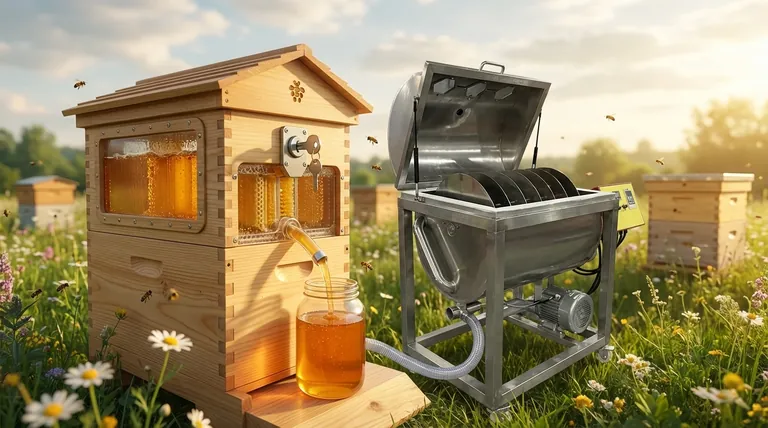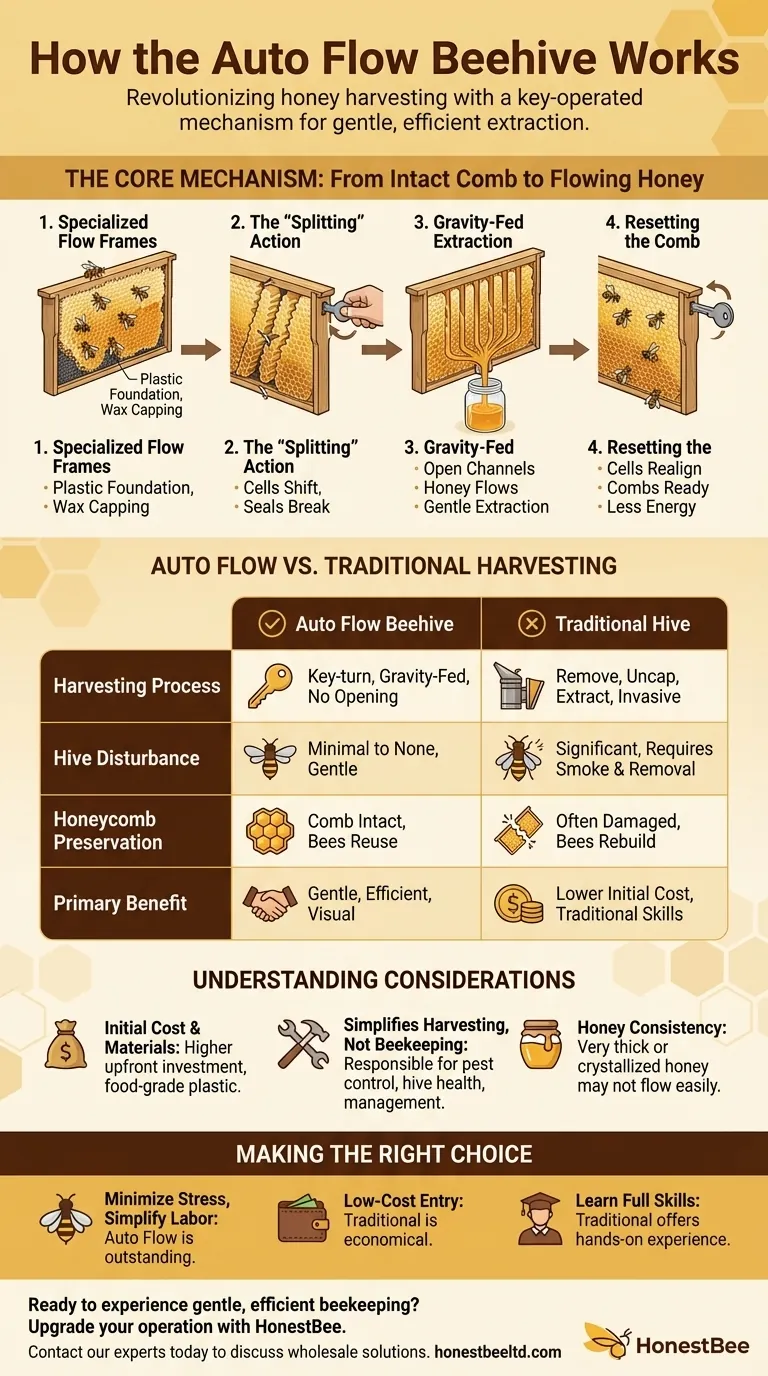At its core, the Auto Flow Beehive works by using a special key-operated mechanism. This system turns a solid honeycomb into a series of open channels, allowing pure, untouched honey to drain directly from the hive into a jar without opening the lid or disturbing the bees.
The revolutionary aspect of the Auto Flow Beehive is not just the mechanism itself, but how it fundamentally separates the act of harvesting honey from the act of opening and disrupting the hive, changing the dynamic for both the beekeeper and the bees.

The Core Mechanism: From Intact Comb to Flowing Honey
To understand how this system works, we need to look at its most critical component: the patented Flow Frames. These frames replace the standard wooden frames found in a traditional beehive's honey super (the box where surplus honey is stored).
The Specialized Flow Frames
The Flow Frames contain partially formed plastic honeycomb cells. The bees complete these cells with their own wax, fill them with honey, and cap them with wax just as they would in a completely natural comb.
The "Splitting" Action
When the beekeeper is ready to harvest, they insert a special key or lever into an external slot on the frame. Turning this key shifts the cells vertically, misaligning the two halves of the comb.
This misalignment breaks the wax seals and transforms the sealed cells into open channels running through the comb.
Gravity-Fed Extraction
With the channels now open, gravity takes over. The honey flows down these channels, through a collection tube at the bottom of the frame, and out of the hive. The beekeeper simply places a jar under the spigot to collect the fresh, filtered honey.
Resetting the Comb
Once the honey has drained, the beekeeper turns the key back to its original position. This realigns the cells, leaving them ready for the bees to repair the wax seals and begin refilling them with honey. The intricate honeycomb structure remains intact, saving the bees immense time and energy.
How This Differs from Traditional Harvesting
The Auto Flow method is a significant departure from the centuries-old practice of honey extraction, which is a far more invasive and labor-intensive process.
Eliminating Hive Disruption
Traditional harvesting requires the beekeeper to smoke the bees to calm them, open the hive, physically remove the heavy frames, and brush the bees off. This is a stressful event for the colony. The Auto Flow system avoids this entirely.
Preserving the Honeycomb
With traditional methods, the beekeeper must scrape the wax cappings off each frame with a hot knife. The frames are then placed in a centrifuge (an extractor) that spins at high speed to force the honey out. This process can easily damage the delicate wax comb.
Because the Auto Flow frames remain undamaged, the bees do not have to expend resources rebuilding their comb and can immediately begin producing more honey.
A Familiar Foundation
Despite its revolutionary frames, the hive box itself is based on the Langstroth hive, a widely used industry standard. This means the core principles of beekeeping and hive management remain familiar to those with experience.
Understanding the Trade-offs and Considerations
While the benefits are clear, objectivity requires acknowledging the practical considerations of this system.
Initial Cost and Materials
Auto Flow hives represent a higher upfront investment compared to traditional Langstroth hives. Additionally, the frames are made of food-grade plastic, which is a point of philosophical debate for some beekeeping purists who prefer all-natural wooden and wax components.
It Simplifies Harvesting, Not Beekeeping
It is critical to understand that this technology only simplifies the harvesting step. The beekeeper is still entirely responsible for all other aspects of animal husbandry, including monitoring for pests and diseases, ensuring the colony is strong, and managing space within the hive.
Honey Consistency
While effective for most common types of honey, very thick or highly crystallized honey (such as canola honey) may not flow as easily through the system. This is a factor to consider based on the primary nectar sources in your area.
Making the Right Choice for Your Goal
Ultimately, the decision to use an Auto Flow Beehive depends on your specific priorities as a beekeeper.
- If your primary focus is minimizing stress on the bees and simplifying the physical labor of harvesting: The Auto Flow system is an outstanding choice that makes the experience gentle and visually engaging.
- If your primary focus is a traditional, low-cost entry into the craft: Standard Langstroth hives with conventional extraction methods remain the most economical starting point.
- If your primary focus is learning the full cycle of traditional beekeeping skills: Working with standard frames, including uncapping and extraction, is an integral part of that hands-on experience.
By automating the single most disruptive aspect of the process, the Auto Flow Hive redefines the relationship between the beekeeper and the hive.
Summary Table:
| Feature | Auto Flow Beehive | Traditional Hive |
|---|---|---|
| Harvesting Process | Key-turn mechanism; gravity-fed extraction | Remove frames, uncap, spin in extractor |
| Hive Disturbance | Minimal to none; no need to open hive | Significant; requires smoking and frame removal |
| Honeycomb Preservation | Comb remains intact for bees to reuse | Comb is often damaged; bees must rebuild |
| Primary Benefit | Gentle on bees, simplifies labor | Lower initial cost, traditional skills |
Ready to experience gentle, efficient beekeeping?
Upgrade your operation with the revolutionary Auto Flow Beehive system. At HONESTBEE, we supply commercial apiaries and beekeeping equipment distributors with the highest-quality, wholesale-focused equipment to maximize your honey yield while minimizing colony stress.
Contact our experts today to discuss how our solutions can benefit your business.
Visual Guide

Related Products
- Economy Small Scale Honey Dryer Dehumidifier Thickening Machine
- Commercial Grade Vertical Electric Bee Sweeper for Bee Removal
- Professional Hive Top Bee Feeder for Beekeeping
- HONESTBEE 72 Frame Industrial Electric Honey Extractor for Beekeeping
- Commercial 48-Frame Stainless Steel Honey Extractor
People Also Ask
- What are the advantages of a condensation honey dryer? Boost Quality & Yield for Your Apiary
- What are some tips for preventing excess moisture in honey during harvesting? Essential Steps for a Stable Harvest
- How can the moisture content of honey be reduced? A Guide to Safe, Effective Drying Methods
- How much honey can a honey dryer process and by what percentage does it reduce moisture? Optimize Your Honey Production
- How does temperature regulation help in managing honey moisture content? Prevent Fermentation & Ensure Quality



















